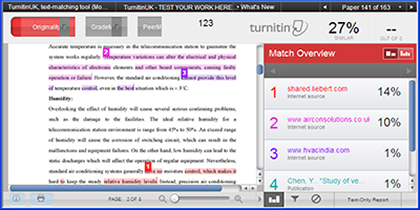
December 14, 2012, by Teaching at Nottingham
Turnitin: is it true that…?
Helen Whitehead: “We get a lot of calls about what Turnitin can and can’t do for staff and for students; here are your top 6 questions, with our answers and suggestions:”
Q: Does Turnitin compare a paper against books, or is it just websites? Are the journals in my discipline included?
A: If the books are only available in printed format then Turnitin will not be able to compare a submission to those books. Similarly, some specialist journals and collections are not included in Turnitin’s database. However, the company claims that the materials that students usually copy from are mostly covered by their search – websites, most online journals and submissions by other students.
Q: Don’t students use the practice version of Turnitin to learn to avoid detection?
A: That’s a possibility, but the way we’ve set it up at Nottingham, students have to wait 24 hours between submissions on the open access version of Turnitin, so it’s difficult for them to make many trial-and-error changes in a short space of time.
Q: Should I ask students to keep resubmitting within my module until they’ve got a low score? Will that stop them plagiarising?
A: That will only show you that they can paraphrase sufficiently to “pass” Turnitin. Since the Similarity Index % scores are just a measure of the amount of text that is matched, it is not directly judging their work practices. An alternative approach might be to make students submit early drafts (perhaps for peer reviewing) or have them mark samples of work as part of teaching them about good writing.
Q: At what score on the Similarity Index % should I start to worry and look at Originality Reports?
A: There’s no straight numerical answer to this one. An “acceptable” Similarity Index % depends on the type of assignment and the subject area. The only way to make a judgement on the student’s writing skills is to look at the Originality Report.
Q: Does the Similarity Index % tell me how much plagiarism there is?
A: The Similarity Index % just shows you how much of the student’s work can be matched to sources in Turnitin’s database. That will include matched text that is cited and referenced correctly, references listed at the end of the essay and common phrases over a certain length (which are especially likely to be matched in lab and practical reports), as well as any text that the student may have copied from a website. Hence a large score may indicate over reliance on direct quotations that are properly cited, good adherence to scientific reporting conventions, or plagiarism/collusion.
And the big one:
Q: So does Turnitin detect plagiarism or not?
A: Maybe! Turnitin can only ever indicate that there are matches to text in its database. Whether that has arisen because of plagiarism, or because of poor writing ability or for an entirely acceptable reason is a judgement for the assessor to make. The Originality Reports will let you see whether there is some kind of problem to be addressed.
Further reading:
Setting up Turnitin assignments in Moodle
About Turnitin on the University’s T&L website
University policy on academic offences
Academic integrity and plagiarism: resources for staff and students
If you want to talk about how Turnitin works and how to set it up in your teaching and assessment, then please call Helen Whitehead or email learning-team-support@nottingham.ac.uk
To discuss interpretation of Turnitin reports or your assessment design practices, please call Rachel Scudamore or email rachel.scudamore@nottingham.ac.uk
Compiling this blog post of our most common questions was prompted by reading “The top 15 misconceptions about Turnitin”, published on the Turnitin blog, and thinking about whether we could see some of those misunderstandings in conversations with colleagues.

[…] Turnitin: is it true that…? from the University of Nottingham’s Talking of Teaching blog. […]
[…] is an edited re-post of my original blog post at the University of Nottingham Talking of Teaching blog and inspired by “The top 15 misconceptions about Turnitin”, published on the Turnitin blog, and […]